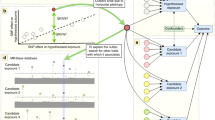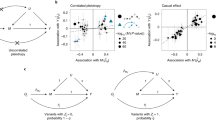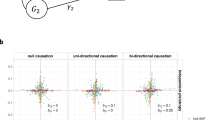Abstract
Horizontal pleiotropy occurs when the variant has an effect on disease outside of its effect on the exposure in Mendelian randomization (MR). Violation of the ‘no horizontal pleiotropy’ assumption can cause severe bias in MR. We developed the Mendelian randomization pleiotropy residual sum and outlier (MR-PRESSO) test to identify horizontal pleiotropic outliers in multi-instrument summary-level MR testing. We showed using simulations that the MR-PRESSO test is best suited when horizontal pleiotropy occurs in <50% of instruments. Next we applied the MR-PRESSO test, along with several other MR tests, to complex traits and diseases and found that horizontal pleiotropy (i) was detectable in over 48% of significant causal relationships in MR; (ii) introduced distortions in the causal estimates in MR that ranged on average from –131% to 201%; (iii) induced false-positive causal relationships in up to 10% of relationships; and (iv) could be corrected in some but not all instances.
This is a preview of subscription content, access via your institution
Access options
Access Nature and 54 other Nature Portfolio journals
Get Nature+, our best-value online-access subscription
$29.99 / 30 days
cancel any time
Subscribe to this journal
Receive 12 print issues and online access
$209.00 per year
only $17.42 per issue
Buy this article
- Purchase on SpringerLink
- Instant access to full article PDF
Prices may be subject to local taxes which are calculated during checkout


Similar content being viewed by others
Change history
02 July 2018
In the version of this article initially published, the Supplementary Text and Figures file was missing Supplementary Tables 4, 6, 8 and 10–14. The correct file has now been provided online.
References
Vasan, R. S. Biomarkers of cardiovascular disease: molecular basis and practical considerations. Circulation 113, 2335–2362 (2006).
Ebrahim, S. & Davey Smith, G. Mendelian randomization: can genetic epidemiology help redress the failures of observational epidemiology? Hum. Genet. 123, 15–33 (2008).
Smith, G. D. & Ebrahim, S. ‘Mendelian randomization’: can genetic epidemiology contribute to understanding environmental determinants of disease? Int. J. Epidemiol. 32, 1–22 (2003).
Evans, D. M. & Smith, G. D. Mendelian randomization: new applications in the coming age of hypothesis-free causality. Annu. Rev. Genomics Hum. Genet. 16, 327–350 (2015).
Burgess, S., Bowden, J., Fall, T., Ingelsson, E. & Thompson, S. G. Sensitivity analyses for robust causal inference from Mendelian randomization analyses with multiple genetic variants. Epidemiology 28, 30–42 (2017).
Burgess, S. et al. Using published data in Mendelian randomization: a blueprint for efficient identification of causal risk factors. Eur. J. Epidemiol. 30, 543–552 (2015).
Solovieff, N., Cotsapas, C., Lee, P. H., Purcell, S. M. & Smoller, J. W. Pleiotropy in complex traits: challenges and strategies. Nat. Rev. Genet. 14, 483–495 (2013).
Bulik-Sullivan, B. et al. An atlas of genetic correlations across human diseases and traits. Nat. Genet. 47, 1236–1241 (2015).
Sivakumaran, S. et al. Abundant pleiotropy in human complex diseases and traits. Am. J. Hum. Genet. 89, 607–618 (2011).
Gratten, J. & Visscher, P. M. Genetic pleiotropy in complex traits and diseases: implications for genomic medicine. Genome Med. 8, 78 (2016).
Parkes, M., Cortes, A., van Heel, D. A. & Brown, M. A. Genetic insights into common pathways and complex relationships among immune-mediated diseases. Nat. Rev. Genet. 14, 661–673 (2013).
Pickrell, J. K. et al. Detection and interpretation of shared genetic influences on 42 human traits. Nat. Genet. 48, 709–717 (2016).
Grassmann, F. et al. Genetic pleiotropy between age-related macular degeneration and 16 complex diseases and traits. Genome Med. 9, 29 (2017).
Webb, T. R. et al. Systematic evaluation of pleiotropy identifies 6 further loci associated with coronary artery disease. J. Am. Coll. Cardiol. 69, 823–836 (2017).
Pickrell, J. Fulfilling the promise of Mendelian randomization. bioRxiv https://doi.org/10.1101/018150 (2015).
Smith, G. D. Mendelian randomization: a premature burial? bioRxiv https://doi.org/10.1101/021386 (2015).
Greco, M. F. D., Minelli, C., Sheehan, N. A. & Thompson, J. R. Detecting pleiotropy in Mendelian randomisation studies with summary data and a continuous outcome. Stat. Med. 34, 2926–2940 (2015).
Bowden, J. et al. A framework for the investigation of pleiotropy in two-sample summary data Mendelian randomization. Statist. Med. https://doi.org/10.1002/sim.7221 (2017).
Bowden, J. et al. Improving the accuracy of two-sample summary data Mendelian randomization: moving beyond the NOME assumption. bioRxiv https://doi.org/10.1101/159442 (2017).
Bowden, J., Smith, G. D. & Burgess, S. Mendelian randomization with invalid instruments: effect estimation and bias detection through Egger regression. Int. J. Epidemiol. 44, 512–525 (2015).
Bowden, J. et al. Assessing the suitability of summary data for two-sample Mendelian randomization analyses using MR-Egger regression: the role of the I2 statistic. Int. J. Epidemiol. 45, 1961–1974 (2016).
Do, R. et al. Common variants associated with plasma triglycerides and risk for coronary artery disease. Nat. Genet. 45, 1345–1352 (2013).
Burgess, S. & Thompson, S. G. Multivariable Mendelian randomization: the use of pleiotropic genetic variants to estimate causal effects. Am. J. Epidemiol. 181, 251–260 (2015).
Corbin, L. J. et al. Body mass index as a modifiable risk factor for type 2 diabetes: refining and understanding causal estimates using Mendelian randomisation. Diabetes 65, 3002–3007 (2016).
Fox, J. & Long, J. S. Modern Methods of Data Analysis (Sage Publications, Thousand Oaks, CA, USA, 1990).
Bowden, J., Davey Smith, G., Haycock, P. C. & Burgess, S. Consistent estimation in Mendelian randomization with some invalid instruments using a weighted median estimator. Genet. Epidemiol. 40, 304–314 (2016).
Hartwig, F. P., Davey Smith, G. & Bowden, J. Robust inference in summary data Mendelian randomization via the zero modal pleiotropy assumption. Int. J. Epidemiol. https://doi.org/10.1093/ije/dyx102.
MacArthur, J. et al. The new NHGRI-EBI catalog of published genome-wide association studies (GWAS Catalog). Nucleic Acids Res. 45, D896–D901 (2017).
Cohen, J. C., Boerwinkle, E., Mosley, T. H. & Hobbs, H. H. Sequence variations in PCSK9, low LDL, and protection against coronary heart disease. N. Engl. J. Med. 354, 1264–1272 (2006).
Warren, H. R. et al. Genome-wide association analysis identifies novel blood pressure loci and offers biological insights into cardiovascular risk. Nat. Genet. 49, 403–415 (2017).
Ehret, G. B. et al. The genetics of blood pressure regulation and its target organs from association studies in 342,415 individuals. Nat. Genet. 48, 1171–1184 (2016).
Liu, C. et al. Meta-analysis identifies common and rare variants influencing blood pressure and overlapping with metabolic trait loci. Nat. Genet. 48, 1162–1170 (2016).
Holmes, M. V. et al. Causal effects of body mass index on cardiometabolic traits and events: a Mendelian randomization analysis. Am. J. Hum. Genet. 94, 198–208 (2014).
Lyngdoh, T. et al. Serum uric acid and adiposity: deciphering causality using a bidirectional Mendelian randomization approach. PLoS One 7, e39321 (2012).
Hemani, G. et al. Automating Mendelian randomization through machine learning to construct a putative causal map of the human phenome. bioRxiv https://doi.org/10.1101/173682 (2017).
Plenge, R. M., Scolnick, E. M. & Altshuler, D. Validating therapeutic targets through human genetics. Nat. Rev. Drug Discov. 12, 581–594 (2013).
Mokry, L. E., Ahmad, O., Forgetta, V., Thanassoulis, G. & Richards, J. B. Mendelian randomisation applied to drug development in cardiovascular disease: a review. J. Med. Genet. 52, 71–79 (2015).
Burgess, S., Butterworth, A. & Thompson, S. G. Mendelian randomization analysis with multiple genetic variants using summarized data. Genet. Epidemiol. 37, 658–665 (2013).
Pasaniuc, B. et al. Fast and accurate imputation of summary statistics enhances evidence of functional enrichment. Bioinformatics 30, 2906–2914 (2014).
1000 Genomes Project Consortium. et al. A global reference for human genetic variation. Nature 526, 68–74 (2015).
Acknowledgements
We thank the various GWA consortia for generously sharing the GWA summary statistics. We thank A. Dobbyn and D. Jordan for critical comments on the manuscript. R.D. is supported by R35GM124836 from the National Institute Of General Medical Sciences of the US National Institutes of Health, R01HL139865 from the National Heart, Lung, Blood Institute of the US National Institutes of Health, research grants from AstraZeneca and Goldfinch Bio and, previously, an American Heart Association Cardiovascular Genome-Phenome Discovery grant (15CVGPSD27130014). B.N. is supported by 1R01MH094469, 1R01MH107649-01 and 5U01HG009088-02 from the US National Institutes of Health. The content is solely the responsibility of the authors and does not necessarily represent the official views of the National Institutes of Health.
Author information
Authors and Affiliations
Contributions
M.V. and C.-Y.C. contributed to study conception, data analysis, interpretation of the results and drafting of the manuscript; and R.D. and B.N. contributed to study conception, interpretation of the results and critical revision of the manuscript.
Corresponding authors
Ethics declarations
Competing interests
B.N. is a member of Deep Genomics Scientific Advisory Board, has received travel expenses from Illumina, and also serves as a consultant for Avanir and Trigeminal solutions; R.D. has received research support from AstraZeneca and Goldfinch Bio.
Additional information
Publisher’s note: Springer Nature remains neutral with regard to jurisdictional claims in published maps and institutional affiliations.
Integrated supplementary information
Supplementary Figure 1 General framework for Mendelian randomization with violation of the exclusion restriction criterion (assumption 3).
a) Direct horizontal pleiotropic effect. b) Mediated horizontal pleiotropic effect. The genetic variant Gj has a significant effect on the outcome Y, which is not mediated by exposure E1 which is called a horizontal pleiotropic effect. Figure a shows a direct horizontal pleiotropic effect of the instrumental variable (IV) on the outcome. Figure b shows a horizontal pleiotropic effect of the IV on the outcome, through a second exposure (E2) causal to the outcome.
Supplementary Figure 2 Representative example of effect sizes of body mass index (BMI) and C-reactive protein.
The red data point represents a single nucleotide variant (rs2075650) that was detected as an outlier by the MR-PRESSO outlier test. The slope of the two lines represent the causal estimates from the naïve inverse variance weighted (IVW) regression (blue; n = 93) and IVW regression after removal of the outlier variant, rs2075650 (red; n = 92).
Supplementary Figure 3 General framework for standard Mendelian randomization.
The general Mendelian randomization framework infers causality of the exposure E1 on the outcome Y using the Gj variants as IVs, given the confounders U. The validity of Mendelian randomization relies on three assumptions: 1) The genetic variant is associated with the exposure E1; 2) The genetic variant is independent of confounders U; 3) The genetic variant is independent of the outcome Y conditional on the exposure E1 and confounders U. This third assumption is usually referred to as the ‘exclusion restriction’ criterion. Confounders are unmeasured in this model.
Supplementary information
Supplementary Text and Figures
Supplementary Figures 1–3, Supplementary Note 1 and Supplementary Tables 1–4, 6, 8, 10–14
Supplementary Tables
Supplementary Tables 5, 7, and 9
Rights and permissions
About this article
Cite this article
Verbanck, M., Chen, CY., Neale, B. et al. Detection of widespread horizontal pleiotropy in causal relationships inferred from Mendelian randomization between complex traits and diseases. Nat Genet 50, 693–698 (2018). https://doi.org/10.1038/s41588-018-0099-7
Received:
Accepted:
Published:
Issue Date:
DOI: https://doi.org/10.1038/s41588-018-0099-7
This article is cited by
-
Causal relationship between rheumatoid arthritis and carpal tunnel syndrome: a bidirectional two-sample Mendelian randomization study
Journal of Orthopaedic Surgery and Research (2024)
-
Association between retinal nerve fiber layer thickness and psychiatric disorders: a mendelian randomization study
BMC Psychiatry (2024)
-
The causal relationship between immune cells and ankylosing spondylitis: a bidirectional Mendelian randomization study
Arthritis Research & Therapy (2024)
-
Daytime napping and the incidence of Parkinson’s disease: a prospective cohort study with Mendelian randomization
BMC Medicine (2024)
-
Impact of periodontitis on type 2 diabetes: a bioinformatic analysis
BMC Oral Health (2024)



